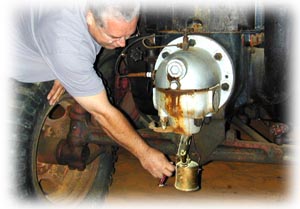Ursus, 1940, Sirkin
The tractor was used at its seniority as a motor for a water pump in Tzipori. It was transferred to Ein Harod by Abed where it was disassembled. Attempt to reassemble it was failed. Additional similar tractor was stored in the Jewish Agency warehouse and was never sold. Later it was transfrerred to Sirkinand furthere Kurdani where it served as a monument. Eventually it was sent back to Sirkin. Both tractors were merged into one.
The Ursus plant is a Polish manufacturer of agricultural machinery located in Lublin and was founded in 1893 by three engineers and four businessmen. It started to produce combustion engines and later trucks and metal fittings designed for the Russian Tsar.
In 1930, the Ursus plant fell on hard times due to the global financial crisis and was nationalized by a Polish manufacturer of weapons and vehicles.
The factory then began to produce military tractors, tanks and other heavy machinery for soldiers. During the German occupation of Poland during World War II, the factory was controlled by FAMO and produced Panzer II, Marder II and Wespe AFV (Tanks based on German knowledge), and after the war, the Ursus C-45, which was a copy of the German Lanz Bulldog tractor before the war. In the 1950s, the Ursus plant began to produce tractors using a Zetor-based design.
In 1961 there was a growing need for tractors in Poland, but the tractors produced by Ursus did not meet the needs of Polish agriculture. A bilateral agreement was signed between Poland and Czechoslovakia, where Czechoslovakia would supply the Ursus plant with the necessary parts to enlarge the plant. In return, Poland would supply raw materials to the factories of Czechoslovakia. The aim was to establish a joint tractor industry in which Poland and Czechoslovakia were to produce 120,000 tractors a year. They managed to produce 15,000 per year.

